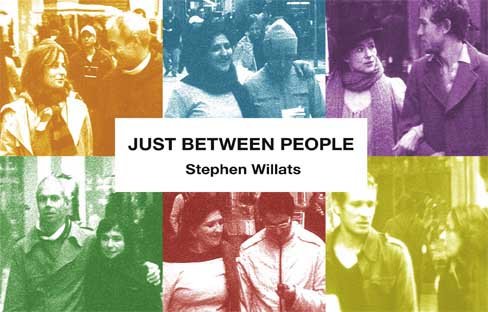Stephen Willats
dal 10/5/2007 al 22/6/2007
Segnalato da
10/5/2007
Stephen Willats
Galerie Reinhard Hauff, Stuttgart
The central piece of the exhibition brings the street with its noise into the gallery. In couples, people keep coming towards the visitor as he in turn can follow their passage. Street signs, logos and flags are visual clues within this micro-territory which give the Stuttgart location away.

Just Between People
Königstrasse - the shopping street in downtown Stuttgart - is crowded
on a Saturday morning with an endless flow of passers-by. Stephen
Willats (*1943) and his crew of camera and sound assistants, models and
volunteers are filming and recording sights and sounds of the scene in
an architectural landscape that could be anywhere in the world in 2007.
Back in his London studio Willats composes the material gathered -
choosing, cutting, pacing and mixing. The result is the twin panel and
video central piece of the exhibition "Just Between People" which opens
at Galerie Reinhard Hauff on Friday, May 11th.
The piece brings the street with its noise into the gallery. In
couples, people keep coming towards the visitor as he in turn can
follow their passage past the shopfronts of Karstadt, Orsay and
St.Oliver. Street signs, logos and flags are visual clues within this
micro-territory which give the Stuttgart location away - if you look
closely. Willats does not offer artistic fastfood. He does challenge
you to look closely and to make an effort to find out what is going on
and what this set of inquisitive photo and text montages communicate.
The work is exemplary of Willats' artistic practice and the form he has
consistently given it since inventing in the 1960's a unique method for
depicting "the realm of human interactions and its social context,
thereby creating inter-subjective encounters that literally take place
- in the artist's production of the work, or in the viewers' reception
of it - or which exist hypothetically, as a potential outcome of our
encounter with a given piece" (Nicolas Bourriaud). The Stuttgart
panels therefore serve to relate with the other works in the exhibition
which spans 30 years of creative output by an artist credited with
founding British Conceptualism.
A central theme in Willats' oeuvre is the human condition in today's
urban jungle – particularly the low-income end of it - people who are
not at home in the art world. Willats is interested in the population
strata for whom modern high rises and housing estates became ghettos of
concrete - the big, anonymous mass confined there, and its capacity of
individuation against all odds in an oppressing, dead-end everyday.
("Symbols of Location", 1976). Willats observes the process whereby
these people are able to inhabit the world "In a better way" because
they manage by some collective effort to transform the perception of
"not ideal" into "normal". Getting us - the viewers - involved in
thinking about and discussing "how the world is and how it could be"
(the title of a recent Stephen Willats retrospective at the Museum of
Contemporary Art in Siegen, Germany) - that is the bottom line.
The works in the show document the scope and coherence of Willats'
probing into our collective mindset. He decodes (body) language and
relationship dynamics in groups of mainly two or four - experimenting
with visualizations of the sum-total of possible degrees of engagement
open to his protagonists. He manages to compact complex sets of human
interactive processes into the graphic equivalent of formulars in a
sign language that translates the complex into simple. Thus in the 5
panel ("Multi Channel Walk", 1996) Willats proceeds from a start-out
position where every participant is in close circuit alone with
himself, to a new reality where everybody in what has become a group
connects with each other.
In another exercize to visualize opening
one's mind to chance Willats calculates the number of encounters
potentially available to random people in the street. It turns out to
be many more than meets the eye. ("Random Moments In Simultaneous
Encounters", 2000/2001). Compositions like ("Street Moments Amsterdam",
2005) speculate on possible connections that get pulled apart before
actually happening, while ("Coming Nearer and Nearer and Nearer", 2004)
and the Stuttgart piece indicate the nature of various couples'
relationships and frames of mind.
To appreciate the precedence of Stephen Willats' position and body of
work, suffice it to quote Nicolas Bourriaud who in a 1998 publication
coins the term "Relational Aesthetics" to the theory of form and
content practiced so courageously by Willats since way before the
notion of "art being an activity consisting in producing relationships
with the world with signs, people, forms actions and objects" became
"new" in the 90's. It does not change what Willats has been the doing
for 4 decades but it coins a term for his work which truly places it
centrally within Art Now.
Works by Stephen Willats are in prominent public and private
collections all over the world. The artist has exhibited regularly with
Galerie Reinhard Hauff since 1995.
Artist info:
http://www.reinhardhauff.de
Galerie Reinhard Hauff
Paulinenstr. 47 - Stuttgart



